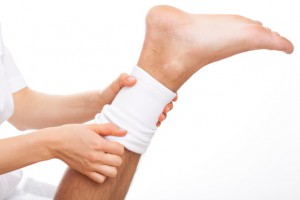As we discussed in Part 1 of our discussion on leg ulcers, which you can access here, there are two types that are caused by leg ulcers. We’ve already talked about arterial leg and foot ulcers in Part 1 and today, we will discuss venous ulcers.
This is the other large category of ulcers that occur on the distal lower extremity. Unlike the arterial ulcers, these ulcers develop in the face of adequate blood supply as measured by standard tests or physical exam. The explanation of why they develop is a little more complex.
How Venous Ulcers Develop
Patients with this type of ulcer have high pressure in their venous system, the conduits that return blood to the heart. This high pressure impedes the ability of the blood to return to the heart. There is congestion that results in swelling in the tissues. The swelling and congestion result in local compromise of oxygen and nutrient delivery to a local area. The skin itself and the body’s defenses in this area are compromised.
Any slight bump or scratch can create an open wound that is painful and fails to heal. Sometimes the skin breaks down spontaneously due to the blood delivery compromise caused by the swelling. At other times, the venous pressure is so high that the patient has spontaneous bleeding from a surface vein.
This wound won’t heal and becomes an ulcer. Once the ulcer is created, the body’s repair crew is ineffective and cannot do its job properly in this environment; no healing occurs. If treatment is not instituted, the ulcer and tissue destruction grow.
Treatment Of Venous Ulcers
Treatment of venous ulcers is similar to a war zone, and like a war zone, needs to be approached on multiple fronts. Here are some appropriate treatment options:
- Surgical procedures such as endovenous laser treatments need to be done on long veins with broken valves that are contributing to the venous hypertension. These long veins can be eliminated, removing their high pressure.
- Proper fitting medical support stockings need to be applied in order to reduce the venous pressure, fight gravity, and allow the swelling that is present in the tissues to return to the circulation.
- Laser treatments or injections can be applied to perforator [connecting] veins to help reduce the pressure and swelling.
- Sclerotherapy should be instituted to control large refluxing residual veins, especially those near the ulcer.
In both types of ulcers, proper wound care is important to help the healing process and prevent infection. However, like arterial ulcers, venous ulcers will not heal until the vascular compromise is taken care of. The key to proper treatment is to seek out a Vascular Surgeon who is Board Certified in Venous and Lymphatic disease to oversee the treatment of venous ulcers.
Dr. Robert Ruess of Nevada’s Five Star Vein Institute has vast experience in the diagnosis and treatment of venous diseases. Schedule an appointment with him at his Las Vegas or Mesquite office location to discuss your specific issue.


